
Following the November 2015 Paris terrorist attacks, Jordan’s King Abdallah proclaimed, “ The world is facing another global conflict, and a fast response is needed to deal with the threat.” [[1]] Indeed, as violent extremist ideologies, groups, and their members spill over into Jordan from neighboring Syria and Iraq, it is important to understand the factors that are radicalizing youth in Jordan. In this regard, a survey was carried out to better understand the factors leading to radicalization in Jordan, including radicalization leading to violence. Between August 2, 2016, and August 4, 2016, a survey of 840 youth ages 16-26 was conducted in Zarqa Central District (n=337), Central Irbid (n=335), and Central Tafileh (n=168). The survey interviews were conducted by means of a questionnaire. The purpose of the survey was to elicit participant perceptions on a range of issues pertaining to radicalization and extremism in the country, specifically their perceptions towards extremist groups, expectations for the future, perceptions towards government approach to dealing with extremism, perceptions towards social media use, and perceptions towards religious authority and entities they trust when it comes to issues related to religious matters. The main goal was to identify potential vulnerabilities among the young in the aforementioned areas, as well to as pave the way to identifying policies that could prevent the future flow of Jordanian foreign fighters into Syria and Iraq and stem the tide of violent attacks inside the country. This report presents some of the most significant findings.
Background: Radicalization and Violent Extremism in Jordan
Since its inception as a modern-day state, Jordan has faced a long history of radicalizing factors, influenced by political events such as waves of refugees and migrants from neighboring turbulent countries as well as the inflow of radical religious ideologies. In recent years, violent extremists and movements began to surface inside the country, and terrorist acts have been committed by many of them since the early 90s. Since the U.S.-led occupation of Iraq in 2003, political and religious radicals emerged as resistance, but soon after turned into lethal organizations, setting up their terrorist organizations first in Iraq and later in Syria following the eruption of the Syrian civil was in 2011, culminating in the creation of ISIS. In addition to these regional instabilities, one has to account for the numerous decades of Israel occupation in Palestine, and lack of development of socio-economic developments in Jordan.
Depending on which statistics are used, Jordan is ranked among the top ten providers of foreign fighters to the Syrian conflict. Jordan also has one of the highest ratios of foreign fighters in the world calculated on a per capita basis, specifically per million of its citizens.[[2]] The Jordanian government does not disclose regular and detailed information about the involvement of its citizens as foreign fighters in the Syrian and the Iraq conflict; therefore, one must rely on independent sources and expert statements and testimonies to calculate the numbers of Jordanians going to Syria and Iraq. Retired Jordanian intelligence (GID) and policy experts estimate that between 2011 and 2015 upwards of 3,000 to 3,950 individuals have traveled to the conflict zone. It is also estimated that anywhere from 250 to 1,500 have been killed.[[3]] Regardless of whether these foreign fighters stay or return, they will continue to pose a threat to Jordan’s national security, whether it be through direct involvement, through proxies, or through their family ties.
Diplomats and analysts residing in Jordan estimate that there are 6,000-7,000 identified Salafi jihadists inside the country.[[4]] Terrorist attacks occurring inside Jordan aimed at police, intelligence, and American military working with Jordanians have also given cause for serious concern. Despite the fact that Jordan is a country with relative political stability and one of the trusting U.S. and coalition partners against ISIS and the Islamic State, it remains an active contributor of foreign fighters to the conflicts in neighboring Syria and Iraq. In addition, it also became vulnerable to attacks mounted inside the country.[[5]]
Previous survey research looking at how Jordanians perceive terrorist groups revealed that many do not see movements like al-Qaeda as terrorist movements at all. For instance, in a series of repeated population surveys carried out in April 2004, respondents representing 67% of the adult population in Jordan defined al-Qaeda as a legitimate resistance movement.[[6]] However, that support fell to only 20% in December of 2005—one month after Zarqawi’s al-Qaeda in Iraq (AQI) bombed three hotels in Amman, Jordan, killing 60 people.[[7]]
In December 2005, following the Amman attacks, 6.2% of Jordanian respondents defined al-Qaeda in Iraq (led by Zarqawi) as a “legitimate resistance organization,” with the rest defining it as terrorist organization or expressing no views. In June 2006, 15.6% of adult Jordanians defined al-Qaeda in Iraq as a legitimate resistance organization.[[8]] Similarly, 84% of the survey respondents in 2004 defined Hezbollah as a legitimate organization.[[9]] This number, however, dropped to 64% after Rafic Hariri was assassinated and to 40% during Hezbollah’s interventions in Syria, respectively. Recent results show only a 20% endorsement rate for Hezbollah as a legitimate resistance organization.[[10]]
On a positive note, the trend since 2004 for the general population in Jordan is to be less supportive of violent extremist movements, reflecting an overall realization that terrorist groups have gone beyond what mainstream people would accept in terms of violent actions. However, social support for terrorist groups and violent extremism waxes and wanes with political shifts, particularly with regards to one’s view on security. To demonstrate, in 2006, during the war with the Israelis, Jordanian’s endorsement for Hezbollah increased again for some time.[[11]]
According to a recent survey research on radicalization in Jordan, 7% of Jordanians (representing 290,000 Jordanians) are credited with endorsing violent extremist groups. This rate has stayed steady since 2010, with endorsement rates for ISIS at 3%, al-Qaeda at 2%, and al-Nusra at 2%. The endorsement rates for these groups also waned in response to political events. For instance, the overall endorsement rate of 7% dropped to 3% when ISIS released their video showing their burning to death of downed fighter pilot Moath al-Kasasbeh in February 2015.[[12]] When survey data was further examined to understand better the profiles of the 7% of Jordanians who usually endorse violent extremists and terrorist groups, it was found that they are more than likely to be 18-24 years of age, males, and often Jordanians of Palestinian origins. They are also more likely to be living in urban areas, belonging to families with an average monthly income of 800 JD (i.e. middle class), and having a university or advanced education.[[13]] Arguably, not only impoverished or undereducated youth are at risk of radicalization and extremism.
The youth radicalization survey was carried out to understand better the factors leading to radicalization in Jordan, including radicalization leading to violence. The main purpose of the survey was to identify potential vulnerabilities among youth, as well as to generate policies that could prevent the future flow of Jordanian foreign fighters into Syria and Iraq and stem the tide of violent attacks inside the country.
Methodology and Limitations
Between August 2, 2016, and August 4, 2016, a survey of 840 youth ages 16-26 was conducted in Zarqa Central District, Central Irbid, and Central Tafileh. Approximately 80 % of the respondents were representative of the Zarqa Central District (40%) and Central Irbid (40%), and 20 % were from Tafileh. The sample was comprised of both males and females, with a relatively even distribution among the two genders. The study relied on non-probability, convenience sampling strategy; therefore, despite the relatively large sample sizes represented across three separate areas, the degree of generalizability remains unknown. Because the survey was conducted at a single point in time, the findings remain limited in measuring changes in perception among the samples studied. To achieve more accurate projections and measure changes in perception among the samples studied, more frequent surveys are needed (e.g. surveys administered at two different points in time). Lack of time and funding also place constraints to using such surveys to gather data. Equally important, because data were self-reported by the respondents, several potential forms of biases might have occurred (e.g. social desirability bias, bias occurring due to the respondent’s feelings at the time of completing the questionnaire, fears of answering honestly about sensitive subjects, etc.), which may have affected the validity and reliability of the study.
Zarqa and Irbid were chosen primarily because they have been identified by experts as hotbeds of radicalization. Tafileh, although a calmer area compared to Zarqa and Irbid, is known for its high loyalty base to the King. Rusaifa (in Zarqa district) is the hometown of al-Qaeda ideologue, Abu Muhammad al-Maqdisi while Zarqa, Jordan’s second largest city, is the birthplace of former al-Qaeda in Iraq’s leader, Abu Musab al-Zarqawi. Two of Jordan’s most prominent ISIS supporters, radical cleric Omar Mahdi Zeidan and Salafi scholar Abu Muhammad al-Tahawi, respectively, are from Irbid. Zarqa and Irbid host large Palestinian refugee camps.[[14]]
Data were collected by six teams comprised of four field data collectors. Each data collection team was accompanied by a field supervisor. The survey was conducted by means of a questionnaire hosted on handheld LENOVO smart tables. The questionnaire and responses were coded via CSPro. To ensure data quality and integrity, three rounds of data verification following the survey were completed. SPSS was used to analyze the data.
Results and Analysis
Youth Endorsement of Extremists Groups
An overwhelming majority of respondents from all three governorates did not express their endorsement for extremist groups. In Zarqa, only 4.5% of youth stated that ISIS is close to their personal convictions, compared to only 2.7% who stated the same about al-Qaeda. In Irbid, only 1.5% endorsed ISIS, and another 1.5% endorsed al-Qaeda. No one endorsed ISIS in Tafileh while al-Qaeda received a 2.4% endorsement rate.[[15]] Although relatively small, the data confirms that Zarqa and Irbid governorates remain the hotbeds of extremism for youth. The findings are not surprising considering these two governorates, in particular, are historically a product of an Islamic identity, nationalism, militant organizations, and lack of economic development that have fostered a fertile environment for radicalization and extremism.
Chart 1.
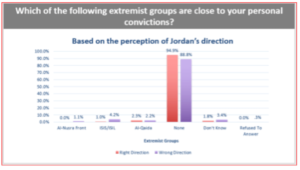
Beginning with a decades-long history of violent extremist and terrorist movements operating in Jordan, and involving Jordanians, along with the destabilizing and radicalizing factors occurring in the region and globally, Jordan has found itself pulled into a global storm involving terrorist groups and their ideologies, with al-Nusra (the local Syrian arm of al-Qaeda) and ISIS operating in Syria and Iraq at its current center. Likewise, the repeated influx of refugees from neighboring conflicts, economic and governance challenges, and Salafi influences migrating into Jordan have all combined to create vulnerabilities and motivations on a psychosocial level that have ideological resonance to terrorist recruitment inside Jordan.
Jihadist ideologies have made their way into the hearts and minds of a subset of Jordanians in recent years, as the mainstream culture has changed tremendously with moves toward a more conservative practice of Islam in many aspects of Jordanian society.[[16]] One aspect of radicalization in Jordan that should not be overlooked is the widespread support for violent Palestinian resistance against the Israeli occupation, including the use of suicide terror attacks. It is common to hear Palestinians in Jordan, including in Zarqa and Irbid, argue that attacks in Israel that target civilians are not terrorism, but rather legitimate resistance to the occupation. Such arguments, unfortunately, pave the way for acceptance of the brutality of groups like al-Qaeda and ISIS that support suicide operations aimed at civilian targets and claim them to be a form of Islamic “martyrdom” to be glorified and a legitimate way to fight towards a desired political outcome. The U.S. coalition invasion and occupation of Iraq, coupled with sectarian strife in Iraq and subsequent eruption of sectarian conflicts in Syria, also did much to underline the jihadist narrative that Islam is under attack and that good Muslims need to fight jihad to protect their Islamic brothers and sisters.
The findings reflect vulnerabilities among youth vis-à-vis violent extremism in all three governorates. This also shows the ability of radical and terrorist groups to appeal and popularize an exclusive Islamic identity and provide forums for interaction and networking that resonates with the youth in the region. Given that more than 70 % of Jordan’s population is under the age of 30, there is a need to support social, political, economic, and educational alternatives as a means to narrowing the gap for groups that promote violence as a solution to contentious socio-political issues in the country.[[17]]
Perception of Jordan’s Direction in Regard to Governance in General
When asked about their perception of Jordan’s direction in regard to governance in general, the responses were almost evenly distributed: 47.1% of the respondents stating that Jordan is moving in the right direction and 42.6% stating that it is moving in the wrong direction, while almost 9 % of the respondents stated a lack of knowledge as to what is driving Jordan and towards which future.
Chart 2.
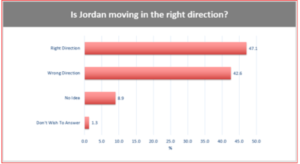
Those who felt Jordan was going in the wrong direction were also more likely to state that ISIS (4.2%), al-Nusra (1.1%), or al-Qaeda (2.2%) represented their personal convictions. In other words, those who have not categorically rejected any of the terrorist groups have also expressed their belief that Jordan is not headed in the right direction.
Chart 3.

When asked to share their confidence in government efforts to curb extremist ideologies in the country, almost 39 % of the respondents in Zarqa, 36 % in Irbid, and 44 % in Tafileh expressed their doubts in the government efforts. Equally important, almost 39% of the sample population have doubts in government efforts. Tafileh respondents expressed a greater lack of confidence in government efforts compared to Zarqa and Irbid.
Chart 4.
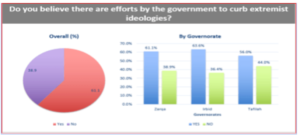
When broken down by educational level, approximately 37 % of the respondents with high school education expressed their lack of confidence in their government’s ability to curb extremist ideologies in the country. In the case of those with higher educational credentials, almost 48 % of respondents expressed their distrust in government efforts. In other words, the more educated the respondent were, the more likely they were to express their lack of confidence in the government efforts. Moreover, 31 % of respondents without a high school diploma expressed their lack of confidence in their government efforts.
Chart 5.
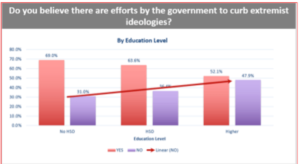
Interpreting the data, factors such as high youth unemployment and perceptions of government corruption and nepotism can also fuel support for extremist groups and ideologies. In fact, in neighboring Iraq—also in line with the survey findings and contrary to some assumptions—perceptions of government “as unjust, unresponsive, and accountable” and not necessarily sectarian violence are what compels many to extend support to extremist and terrorist organizations. In other words, there is a relationship between lack of efficient governance and support for extremist and terrorist organizations.[[18]]
Strictly speaking in the context of Jordan, many young people continue to struggle to find meaningful forms of employment. In addition, the lack of economic prosperity, coupled with what many described as the institutional failure caused by widespread corruption lack of respect for law and human rights, among others, continue to breed insecurity for its citizens, creating a very dangerous and vulnerable environment, especially for the youth. When asked to elaborate on the issue of governance in general in the Arab world, Jordanian researcher Hasan Abu Hanya shared, “When I go to Europe or when I first begin my speeches, the question I am often asked by the people in the West is, ‘Why do people become extremists?’ But in the Arab world, the question should be, ‘Why don’t they become extremists? In the Arab world, there are political motivations. The economic situation is worse than in the Western world. There is no security. We have the Palestinian issue, sectarianism, oppression, corruption and abuses of power. I love when people ask why? Why this person who is oppressed, marginalized, suffers from poverty, and social injustice—why is he not an extremist?”[[19]]
As discussed above, almost 39% of the sample population have doubts in the government efforts when it comes to curbing extremist ideologies. This may reflect their immediate environment in terms of security and/or lack of confidence in the government present there. Research has also shown that generally speaking, young people often exhibit less confidence in government and political institutions relative to the general population. Research has also shown that confidence can be especially low for those living in urban and rural areas. The lack of trust in government efforts in general, also evident in some of the participant responses, creates a dangerous environment in which young people become a target for extremist and terrorist organizations.[[20]] In this context, building trust with government will remain a key challenge.
As pointed out earlier, the more educated the respondent, the more likely to express a lack of confidence in the government efforts. While this may reflect the level of maturity commensurate to the respondent age and better understanding of the inner workings of government, such a trend also indicates feelings of frustration among the educated with regards to socio-political conditions in the country, which can be real or perceived. Such findings show less importance for one’s economic status. Arguably, not only uneducated youth are at risk of radicalization and extremism.[[21]]
Monthly Income in Regard to Endorsement of Extremist Groups
Endorsement of ISIS increased by monthly income. Those earning between 500 – 800 (and more) Jordanian dinars (JD) seem to find some similarity with ISIS values and their own.
Chart 6.
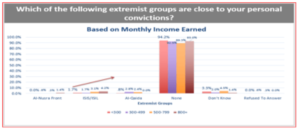
The findings lend some support to a widely-accepted counter-terrorism view that moderately to well-off persons have more resources, time, and ability to be concerned with social and political issues that terrorist groups purport to address. Thus, relatively better off people are more likely to be involved and seduced into terrorist groups and their ideologies than those who are impoverished and consumed with meeting basic survival needs.
Education in Regard to Endorsement of Extremist Groups
Endorsement of all three groups increased by educational level, with those having no high school education rejecting extremist groups entirely. Endorsements for groups like al-Qaeda (2.5 % and 3.1 %) and ISIS (3.4 % and 3.1 %) increased with completing high school and beyond high school. Those without a high school education indicated that they reject extremist group values. Endorsements for al-Nusra also increased in line with an increase in education. Interestingly enough, the more educated the respondent, the more doubtful he or she seems to be in his or her responses to endorsing extremist groups (2.8 % and 5.1 %).[[22]]
Chart 7.

Gender in Regard to Endorsement of Extremist Groups
Among the approximately 2% of youth endorsing ISIS and al-Qaeda in Jordan, the endorsement rates were relatively even between males and females. Only males endorsed al-Nusra at a 1% rate for the sample. Also, 2.4 % of the males were doubtful in their responses to this question. In the case of females, those who endorsed was even higher and stood at 3.5%.
Chart 8.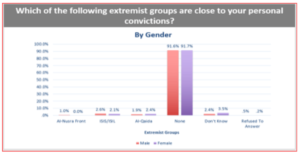
Despite the relatively low support for extremist groups among both male and female, and specifically referring to female perceptions towards extremist groups, the survey data suggest the need to address the needs of young women and girls considered as “high-risk” in terms of radicalization and extremism. In other words, young women’s perceptions, including underlying reasons for such perceptions, must be fully understood and reflected in counter-radicalization and counterterrorism initiatives.
While some have been attracted to the gore and savagery of terrorist organizations such as ISIS and al-Nusra, generally speaking, women and young girls are lured into the conflict zones in Syria and Iraq on the premise that they would be providing humanitarian aid. They are also lured into believing they will be playing an active role alongside men—only to find out they have lost all control once there. In fact, research has shown that terrorist groups like ISIS and al-Nusra limit their role by encouraging them to remain in traditional marriages and bear children for the cause. They also encourage female foreign fighters to join the hisbah (religious police). In addition, they are allowed to teach, provide healthcare, and carry out other duties as long as such roles are limited to interacting with children and other women. Some, particularly Europeans, are even tasked with online recruitment efforts.[[23]]
Similar to counter radicalization measures aimed at men and young boys, there is a need to develop effective counternarratives for women that specifically emphasize the brutality and abuses of terrorist and extremist groups against women. In addition to these much-needed effective counter-narratives, there should also be serious efforts to help women transition through the dangerous radicalization landscape by offering an opportunity for activism, an opportunity for employment, and guidance in general to effectively counter terrorist messaging.
Age in Regard to Endorsement of Extremist Groups
ISIS endorsement decreased with age with twice as many (3.1%) of 16-19- year- olds endorsing compared to 1.4% of 24-26 year olds, but increased in the higher age group for endorsement of al-Qaeda. Endorsement rates increased with education beyond the high school level.[[24]] Among 19 year olds, 4.1 % were doubtful about their responses to their question. That number was even higher among the 24-26 age group.
Chart 9.
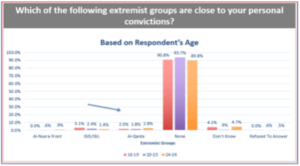
Arguably, the support among youth for groups like ISIS may be credited to the group’s successful online and social media propaganda that has enabled it to attract thousands of young people, more so than al-Qaeda through their fatwas and mostly TV-based proselytizing propaganda. Equally important, ISIS brought to life “Islamic State” while also invoking the sentiments of a “global Caliphate” ruled by Shariah. Comparatively speaking, while ISIS nowadays offers an instant outlet for frustration and recognition for revenge and thrill seekers, al-Qaeda’s slower message of anti-Muslim oppression and its pioneering of the “global jihad” struggle also continues to sit well with many youths worldwide. In other words, al-Qaeda’s message has and continues to play an important role in the developmental needs of many adolescents around the world.
Social Media Use
Facebook is the most popular social media platform for youth in Jordan, with 81% of the youth respondents stating they have an account on Facebook, 39% on Instagram, 30% on YouTube, and 21.3 % on Twitter.[[25]] YouTube browsing is high, even though many stated they had not registered accounts on the video-sharing platform.
Chart 10.

Those with Facebook accounts more often believe Jordan is moving in the wrong direction; however, that rate is close with Facebook users who believe that Jordan is moving in the right direction. Twitter, Instagram, and YouTube users more often believe that Jordan is moving in the wrong direction.[[26]] It appears that more access and connectivity to social media channels, the higher expressions of youth dissatisfaction with Jordan’s direction. YouTube and Twitter, in particular, have been used worldwide, including in Jordan, to spew ISIS propaganda that perhaps influences these responses.
Chart 11.
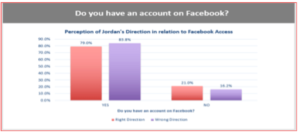
Who to Consult on Religious Matters
When asked about who they consult on religious matters, 43.7% of youth respondents stated they turned to their local mosques while 33.6% to the Jordanian Ifta (Fatwa) Department. [[27]]
Chart 12.
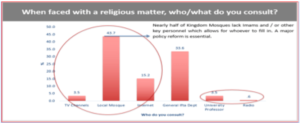
Over fifty percent of the youth respondents said they followed religious organizations and movements via their websites, and this figure rose to 65% for those who viewed Jordan as moving in the wrong direction.[[28]]
Chart 13.
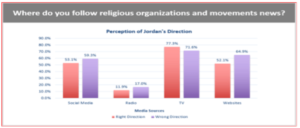
When asked about what they would do upon learning an acquaintance is leaning towards joining an extremist/terrorist organization, only one- third from those living in Zarqa or Irbid districts answered that they would offer advice, inform parents, or report to the authorities, which is concerning.
Chart 14.
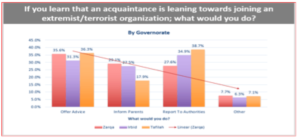
As shown above, the respondents appear to hold religious officials in high esteem. What is evident here is that the respondents do not take religious matters lightly to address them via non-religious platforms—that is, with 43.7 % of the respondents stating they turned to their local mosques while 33.6 % to the Jordanian Ifta (Fatwa). However, given that half of the mosques in Jordan lack imams or other key personnel, anyone can fill in as a “leader” and misguide them, creating a foothold for extremist recruitment. This was particularly true in Zarqa where 47% of the mosques lacked an imam and 20% lacked imams or servants whatsoever, allowing anyone to run the mosque, lead prayers, and teach youth without any monitoring, which remains equally worrisome. [[29]]
This aspect of the survey data was also confirmed in Zarqa in focus testing the International Center for Study of Violent Extremism (ICSVE) videos of ISIS defectors denouncing ISIS.[[30]] Youth there, ages 14-26, shared that they did not know how to answer extremists when they spout out hadiths and Koranic verses in support of violence. But when they turn to their parents and teachers for answers, they find them either unable or preferring not to answer out of fear of being perceived by the Jordanian intelligence as supporting violent extremism. This leaves youth vulnerable, forcing some to turn to the Internet for answers, although many stated they were well aware terrorist recruiters were busy on the Internet stalking them.
According to survey responses, 15.2% of respondents turned to the Internet for questions on religious matters, a worrying pattern given that ISIS and other terrorist groups are ready to pounce on questioning young minds to seduce them into violent extremism, with some employing the Internet in their favor. In fact, 50% of the respondents indicated that they followed some sort of a religious group or organization on the Internet. Consequently, of those respondents, about 65% viewed Jordan as moving in the wrong direction.[[31]] Surprisingly, a number of respondents from Tafileh appear to be actively seeking consultation on religious matters via the web, a source heavily infiltrated by extremist groups.
Social media platforms such as Twitter, Instagram, and YouTube have made communication much easier, especially among youth. They serve as an effective “two-way” street whereby youth instantly get their messages through to their intended targets. In addition, although more research is warranted, a Baylor University study found that social media offers an opportunity for people to easily “customize” their faiths. In the words of sociology researcher McClure, “On Facebook, there is no expectation that one’s ‘likes’ be logically consistent and hidebound by religion…religion, as a result, does not consist of timeless truth…Instead, the Facebook effect is that all spiritual options become commodities and resources that individuals can tailor to meet their needs.” [[32]]
Social media technology will continue to serve as an important communication platform for youth. In this regard, also applied to the survey findings, social media technologies will continue to shape our attitudes towards” religious beliefs and traditional political institutions.” [[33]] As McClure put it, “It will become perfectly acceptable to experiment with other religions and not remain committed to the teachings of a singular tradition.”[[34]] In Jordan, this may not mean traversing outside of Islam, but rather accepting distorted interpretations of Islam as offered by terrorist groups. This is problematic in the sense that youth will continue to fall prey to the propaganda of terrorist group such as ISIS and al-Nusra that offer an exclusive Islamic identity and unified ummah for all of its followers with strict and violent definitions of what being a Muslim means. In this regard, when dealing with youth vulnerable to radicalization and extremism, it is crucial to utilize social media platforms that go beyond traditional radio/TV platforms, meaning emphasis should also be placed on utilizing face-to-face communication and appropriate social media tools and apps (e.g. Facebook, Twitter, WhatsApp etc.). Who and how counter-narrative massages are delivered is equally important.
Conclusion
Although overall support for radical and terrorist movements in Jordan has declined significantly since 2004, there remains some pockets of support for the extreme brand of radical jihadist movements, such as ISIS and Al Qaeda, among all age groups, and particularly among youth. The drivers of radicalization to violent extremism in Jordan are many. Social support for violent extremism in Jordan has a long history in the making.[[35]] Beginning with a decades-long history of violent extremist and terrorist movements operating in Jordan, and involving Jordanians, along with the destabilizing and radicalizing factors occurring in the region and globally, Jordan has found itself pulled into a global storm of terrorist groups and their ideologies, with al-Nusra (the local Syrian arm of al-Qaeda) and ISIS operating in Syria and Iraq at its current center. Likewise, the repeated influx of refugees from neighboring conflicts, economic and governance challenges, and Salafi influences migrating into Jordan have all combined to create vulnerabilities and motivations on a psychosocial level that have ideological resonance to terrorist recruitment inside Jordan.
Jihadist ideologies have made their way into the hearts and minds of a subset of Jordanians in recent years as the mainstream culture has also changed tremendously with moves toward a more conservative practice of Islam in many aspects of Jordanian society.[[36]] Moreover, several important aspects of radicalization in Jordan that should not be overlooked include: the widespread support for violent Palestinian resistance against the Israeli occupation, including the use of suicide terror attacks, the U.S. coalition invasion of Iraq that led to the eruption of sectarian strife, and the sectarian conflicts and terrorist groups operating currently in Iraq and Syria.[[37]]
If there are any conclusions to be drawn from the survey data, it would be that Zarqa and Irbid districts, arguably, continue to remain hotbeds of extremism for youth in Jordan. On a positive note, however, the numbers of those what one would consider as already being on extremist trajectory remain relatively small. Generally speaking, the prevailing distrust towards the government in Jordan, including its approach towards curbing violent extremism and extremist groups in the country, remains worrisome. In fact, the lack of economic development and high unemployment, coupled with what many described as the institutional inefficiency caused by nepotism, corruption, and so forth, continue to breed insecurity of its citizens, creating a very dangerous and vulnerable environment, especially for the youth.
The survey results also show that generally it is more educated and well-off youth that appear radicalized. Thus, it does not appear that economic concerns are their main drivers of endorsement for violent extremism. Likewise, the fact that youth report that they turn to unmanned mosques as well as the Internet for answers about religious issues and would not report radicalized friends to even their family members is equally worrisome. This leaves youth vulnerable to terrorist propaganda and terrorist recruitment. Given that more than 70 % of Jordan’s population is under the age of 30, and the fact that ISIS and the conflicts in Syria and Iraq has managed to seduce over three thousand Jordanians into becoming foreign fighters, there is a strong need to support Jordan, especially when it comes to social, political, economic, and educational alternatives to counter extremist ideologies and groups that promote violence as a solution to contentious socio-political issues in the country.
–——————————————————————————————————–
About the authors: Fares Braizat, Ph.D., is Chairman at NAMA-Strategic Intelligence Solution. Anne Speckhard, Ph.D., is Director at International Center for the Study of Violent Extremism (ICSVE) and Adjunct Associate Professor of Psychology at Georgetown University. Ardian Shajkovci, Ph.D., is Senior Research Fellow and Director of Research at International Center for the Study of Violent Extremism (ICSVE). Amer Sabaileh, Ph.D., is a political analyst and general manager at Triage Duepuntozero.








